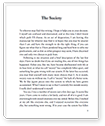Essay Instructions: Case study : Supply chain Whirl
While the 2001 global overhaul of whirlpool?s supply chain systems remains a work in progress today, managers say its success to date is encouraging the remaining system work.
The supply chain whirlpool in 2000 was broken. Indeed, a manger there at the time quipped that among the four major appliance makers in U.S. , Whirlpool ranked fifth in delivery performance.
??We had too much inventory, too little inventory, wrong inventory, right inventory/wrong place, any combination of those things, ??says J.B. Hoyt who was then the supply chain project director. He says a sales vice president approached him one day and said he?d accept even worse performance from supply systems if they would just be consistent rather then wildly bouncing back and forth between good and poor production and shipping plans.
So in 2001, whirlpool embarked on a multi project global overhaul of its supply chain system. The meta project remains a work in progress today, with a number of systems yet to be rolled out and some major technical issues to be resolved. But managers at whirlpool say its success to date including huge improvements in customer service and reduced supply chain costs is providing the psychological and financial impetus to drive the remaining systems work
Whirlpool CIO Esat Sezer says that by 2000, the company had grown by acquisition and geographic expansion to the point that old systems, stitched together by spread sheets and manual procedures, couldn?t cope with the exploding complexity.? Our supply chain was becoming a competitive disadvantage for us,?? he says. Availability ? the percentage of time a product is in the right place at the right time ? was an unacceptably low 83 percent, even as inventories remained too high overall.
The home grown supply systems were primitive and not well integrated with the company?s SAP ERP system, which had been installed in 1999, or with a legacy production scheduling system, Sezer says. And they weren?t integrated with the system major wholesale customers or suppliers of parts and materials. ??The plans we were creating weren?t linking back into reality,?? he says.
In particular, Sezer says, supply chain systems weren?t fine ?grained enough, nor were they very good at juggling priorities and constraints except through slow and cumbersome manual methods. Often, they would optimize locally ? a single product line at one location, for example ? but not for the supply chain as a whole.
Here?s what Whirlpool was using for its North American supply chain in 2000:
- A home grown production scheduling system, the Whirlpool manufacturing control system (WMCS),which was developed in the mid-1980s and extensively modified over the years.
- SAP?s R/3 ERP system, which was installed in 1999 and used for transaction-processing applications such as accounting and order processing.
- I2 technologies demand planner (now called demand manager), which was installed in 1997 and used for demand forecasting.
- A system for distribution planning that was custom-developed for Whirlpool in the 1980s that used optimization software from ILOG.
Then in 2001, Whirlpool began to implement an advanced planning and scheduling (APS) system. It included a suite of supply chain integration and optimization tools from i2 ? Supply chain planner for the master scheduling, Deployment planning and inventory planning. Those three modules, the heart of Whirlpool?s efforts to fix its supply chain, went live in three phases over 2001 and 2002.
In mid-2002, Whirlpool installed the i2 TradeMatrix collaborative planning, forecasting and replenishment (CPFR) system, a web-based collaboration tool for sharing and combining the sales forecasts of Whirlpool and its major trade partners-- Sears, Roebuck and Co., Lowe?s and best buy Co.
The rollout of the a component for Web-based collaboration with suppliers, based on SAP?s inventory collaboration Hub, is just getting under way. And Whirlpool continues to use the old WMCS for production scheduling but plans to replace that with SAP?s production planning module.
It?s available
By all accounts, the supply chain overhaul was a smashing success for the US$13 billion company. CPFR cut forecasting errors in half. APS boosted availability in North America from 83 percent to 93 percent (it?s at 97 percent today), reduced finished-goods inventories by more than 20 percent and trimmed 5 percent from freight and warehouse costs. Whirlpool declined to discuss the cost of the projects.
Managers at Whirlpool give much of the credit for the success of these projects to a close partnership between the IT department and the business units. Says Hoyt, ``it was one of the first times the IT community didn?t say, ?OK, here?s your tool. ?We said the tool had to do x, y and z. We did the requirements analysis together.??
Whirlpool considered standardizing completely on SAP for all ERP and supply chain systems in North America, but i2 ultimately got the nod for the APS system, the critical part needed to fix the company?s availability and inventory problems. ``There was a lot of back and forth, but after a long harangue and discussion of our business requirements, we settled on the i2 tool set in North America, ``Hoyt says.
But while i2 was seen as being more capable than SAP for handling the fine?grained optimization, constraint-based planning and prioritization that the business units wanted, it was far from ideal from an IT perspective. The APS system would cost IT, whose budget is about US$190 million, more than all-SAP supply chain because there would be less integration, more systems interfaces and more skills to maintain in-house. Plus, IT was worried about i2?s deteriorating financial condition.
Whirlpool had already standardized on IBM AIX application servers and zSeries mainframe database servers for supply chain systems and had put systems for all its global operations in a single data center in Benton harbor. Now it was time to standardize on software.
So in 2001, a mandate came from the CIO, via whirlpool?s executive committee, that supply chain modernizations henceforth would be based entirely on SAP. In particular, new systems planned for Europe for 2003 and Latin America would use SAP?s Advanced planner and Optimizer rather than the more capable but costly i2-based APS system used in North America. And they were to use SAP?s NetWeaver for Web collaboration with suppliers and trade partners rather than North America?s TradeMatrix CPFR.
Vivek Mehta, A lead supply chain analyst at Whirlpool, says SAP may catch up with i2 in its optimization capabilities, but in the meantime, i2?s financial condition is worrisome. ``There were 10 guys at i2 that we interacted with, and some of them are gone now, ``he says. ``There?s lack of continuity??.
``We have this challenge, where the IT organization is pushing for everything to be SAP, but the business, on the other hand, is going fro whatever brings them value, ``Mehta says. ``They are now used to the optimal plan, the high service levels, the lower inventories. So if we bring in something and say their availability will go down by couple of points, no way will they buy that.??
Sezer says Whirlpool will probably replace i2 with SAP ``eventually?? but is in no hurry. ``We?d like to get the return out of that investment before making any platform decisions, ``he says.
Sezer says that in the four years since Whirlpool standardized on IBM and SAP as ``strategic partners,?? revenue has increased on average US$1 billion per year and IT expenses have fallen 6 percent per year.He says there are several joint development projects under way involving all three companies.
But for the time being, the combination of SAP and i2 works well for Whirlpool, far better then the legacy tools of a few years ago. Sezer says the company?s supply chain is now a competitive advantage. ``On a global scale, to be able to manage all your operating platforms, I?m not aware that any of our competitors have that today, ``he says.
Think globally, act locally
When time came for Whirlpool Europe to overhaul its supply chain, the company decided not to go with i2 optimization products, as North America had done, but with SAP?s advanced planner and optimizer (APO) for demand and supply-network planning.
Vivek Mehta, a lead supply chain analyst involved in both projects, says Europe was starting from a more primitive systems base, with even more manual procedures and less-integrated systems than had been the case in North America. So for Europe, ``APO was a huge step forward, ``he says.
The integration of Whirlpool Europe?s supply chain systems around APO, though not quite complete, has already boosted inventory availability from less than 80 percent to more than 90 percent, says Walter Manfredi, supply chain director in Whirlpool?s Comerio, Italy, operations center.
``Today, our supply chain is integrated ? process and systems, ``he says. ``Now, demand from a trade partner or customer is integrated into production planning. We can look into production plans and see if this item for this date in this quantity is for this customer. So we can now give priority depending on the type of demand.??
For example, he says, priority is always given to production orders earmarked for specific customers ? for which availability is now 97 percent-- over orders to simply replenish stock.
Still, improvements need to be made, especially at the level of individual factories, Manfredi says. Some factory managers, in an attempt to tweak system rules and parameters to optimize their operations, make the systems so complex that they become maintenance nightmares. And, he adds, attempts by factories to optimize their own performance can be at odds with optimizing the European supply chain overall.
Finally, Manfredi say, while production can be varied daily by altering system rules and parameters, some production modifications require workforce changes or changes in line and equipment capacities, which can take weeks to accomplish. ``That?s very difficult, he notes.
Required : Write a report that answers the following areas:
1) Critically appraise the supply chain management system used by Whirlpool ? North America and evaluate how it contributed to Whirlpool?s business performance and in gaining competitive advantage.
2) Evaluate how Whirlpool?s production helped in making planning and sourcing decision. What set back did Whirlpool face in making delivery decisions that provoked them to move to an optimal platform of supply chain management.
3) Discuss on the future trends and challenges faced by global makers of home appliances in managing their supply chain.
This coursework aims to achieve the following learning outcomes of the module :
- Critically appraise how supply chain management and supplier development can contribute to business performance and competitive advantage
- Critically evaluate planning and sourcing decisions
- Critically evaluate making and delivery decisions
- Identify and discuss future trends and issues in global supply chain management
Resources
Supply chain case studies / Journals of supply chain management / Harvard business review
Supply chain management review / supply chain digest
1)Submission of the paper should follow the standard format , consisting of
- Table of contents
- Executive summary
- Content page
- Main report
- Conclusion
- References (Harvard)
2) Others points to take note
- Printed using Arial font , size 10 , 1-1/2 line spacing
- Do not use first person in your report (no ??I?? , ??me??, ??us??, ??we?? ) Used third person and passive voice
- Avoid making use of jargon. The report should be written in academic form
- Citation and references should be in Harvard referencing format
MARKS
10 marks ? Executive summary , conclusion and references
10 marks ? Presentation and appearance
80 marks ? Contents , Appraise the supply chain management system used by Whirlpool , evaluate
And discuss future trends and challenges faced by global makers of home applicances in managing their supply chain.


